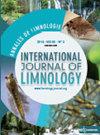Effects of salinity on species composition of zooplankton on Hau River, Mekong Delta, Vietnam
IF 0.9
4区 环境科学与生态学
Q4 LIMNOLOGY
Annales De Limnologie-international Journal of Limnology
Pub Date : 2020-01-01
DOI:10.1051/limn/2020018
引用次数: 6
Abstract
The area surrounding the Hau River is one of the most important aquaculture and fisheries areas in the Mekong Delta, Vietnam. Fish, shrimp farms and fishers rely of the natural zooplankton production in the incoming water to sustain production. Zooplankton samples were collected from July 2017 to June 2018 using a zooplankton net with mesh size of 60 μm at 3 sites on Hau river at Tran De (river mouth), Dai Ngai (midpoint) and Cai Con (farthest salt intrusion area on Hau river). Qualitative and quantitative samples of zooplankton together with salinity level were determined monthly at each sites. The salinity was found to fluctuate from 0 to 20‰ in the study area. A total of 137 zooplankton species were recorded including 26 species of Protozoa (19%), 47 species of Rotifera (34%), 12 species of Cladocera (9%), 44 species of Copepoda (32%) and 8 other taxon (6%). Copepod and rotifer prevailed with high densities (19.9 × 103 ind m−3 and 19.7 × 103 ind m−3, respectively), whereas protozoa and cladocera were less abundant with 6.8 × 103 ind m−3 and 4.9 × 103 ind m−3, respectively. When salinity increased to more than 5, protozoa and copepods were more abundant and reached a peak at 20 with 25.0 × 1036 ind m−3 and 53.0 × 103 ind m−3, respectively. Regression analysis indicated that the density of zooplankton was significantly correlated to salinity variation. Protozoa and copepod were positively correlated with salinity, whereas cladocera and rotifer were negatively correlated with salinity. The impacts of climate change could exacerbate the seasonal fluctuations in salinity and zooplankton composition.盐度对越南湄公河三角洲口河浮游动物种类组成的影响
口河周边地区是越南湄公河三角洲最重要的水产养殖和渔业地区之一。养鱼场、虾场和渔民依靠流入水中的天然浮游动物来维持生产。2017年7月至2018年6月,在河口Tran De、中点Dai Ngai和盐侵最远区Cai Con 3个地点,采用60 μm网目采集浮游动物样本。每个站点每月测定浮游动物的定性和定量样本以及盐度水平。研究区盐度在0 ~ 20‰之间波动。共记录到浮游动物137种,其中原生动物26种(19%),轮虫目47种(34%),枝目12种(9%),桡足目44种(32%),其他8种(6%)。桡足类和轮虫密度较高,分别为19.9 × 103和19.7 × 103和m - 3,原生动物和枝类密度较低,分别为6.8 × 103和4.9 × 103和m - 3。当盐度大于5时,原生动物和桡足动物数量较多,在20时达到峰值,分别为25.0 × 1036和53.0 × 103 ind m - 3。回归分析表明,浮游动物密度与盐度变化呈显著相关。原生动物和桡足动物与盐度呈显著正相关,枝纲动物和轮虫与盐度呈显著负相关。气候变化的影响可能加剧盐度和浮游动物组成的季节性波动。
本文章由计算机程序翻译,如有差异,请以英文原文为准。
求助全文
约1分钟内获得全文
求助全文
来源期刊
CiteScore
2.20
自引率
0.00%
发文量
0
审稿时长
>12 weeks
期刊介绍:
Annales de Limnologie - International Journal of Limnology publishes papers on the ecology of freshwater systems, ranging from studies of aquatic organisms, physical and chemical works which relate to the biological environment, to ecological applications and frameworks for water management directives.
Main topics: Ecology of freshwater systems ; biodiversity, taxonomy, distribution patterns in space and time, biology of animals and plants ; experimental and conceptual studies which integrate laboratory and/or field work on physiology, population dynamics, biogeochemistry and nutrient dynamics, management, mathematical modelling ; techniques for sampling and chemical analyses, ecological applications, procedures which provide frameworks for environmental legislation.

 求助内容:
求助内容: 应助结果提醒方式:
应助结果提醒方式:


